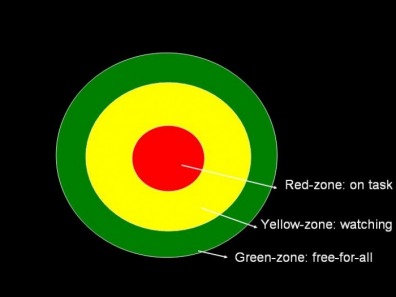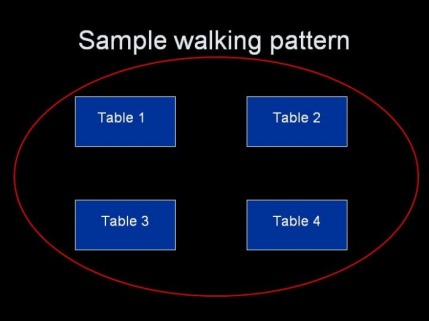Proximity & Modality

Using the previously learned information on students’ motives, Say, See Do teaching, limit setting and Praise, Prompt and Leave, we will now look at the importance of proximity and modality in the classroom. This is one of the greatest tools in preventing misbehavior. I have included it here because this is a tool to use throughout all instructional and independent tasks.
Description:
By nature, students (and all people) will typically do what they want when given an opportunity (known as Bodenheimer’s law). Therefore, students in the zone furthest from the teacher are essentially under less supervision and more likely to misbehave. If looking at the class as zonal in relation to the teacher’s proximity, that furthest point is what is known as the ‘green zone.’ The teacher is not near, so there is greater freedom. Coming in a bit, students are in the ‘yellow zone.’ This means that they are cautious because the teacher has the potential to be near, but still may misbehave if it is viewed safe. This zone extends just beyond the immediate area surrounding the teacher to about six feet out. The area directly around the teacher is known as the ‘red zone.’ Because the teacher is so near, students in this area are much keener to remain on task. They could be ‘caught’ at any given moment. The teacher can use these zones to their advantage. By arranging the desks to allow for walking room, he or she can maintain constant monitoring by walking through the desks. This way, no one person is in one zone for any length of time. With the anticipation that the teacher will soon be coming back by, students are likely to focus, no matter where their proximity is (Jones, 2007).
Significance:
Simply adding mobility to teaching can cut behavior issues dramatically. Students are more alert and engaged, and learning is increased as a result.
Demonstration:
A kindergarten teacher has table groups set up. During teaching and independent practice, he continually walks in a loop he has designed to keep at least one table group in the ‘red zone’ at all times. Anyone who enters his class observes a well-behaved and engaged group of students.
Integral Components:
One of the important aspects of proximity and modality is to maintain a confident posture. As mentioned before, body language is a great indicator of true feelings. Therefore, if the teacher remains walking, but exhibits timid or unsure body language, the walking is much less effective. Conversely, the teacher who walks with a strait posture shoulders relaxed, and head high conveys the idea of ‘meaning business’ to students (Jones, 2007).
Individualization:
I plan to use this concept in every aspect of teaching. Not only does is prevent misbehavior, but also encourages students to engage in their learning, thus making it more effective.
Spiritual Application:
1 Thessalonians 5, seen in Praise, Prompt and Leave, also applies to this section. However, in this case, it is verses 4-6. In it, Paul (the author) tells the people of Thessalonica to be alert and self-controlled in preparation for the coming of the Lord. This applies to us as well. Maintaining proximity can be seen as a form of keeping students alert in class. This training is then good modeling for all aspects of life. Plus, in remaining alert, students are also gaining self-control as they are maintaining longer periods without any misbehavior. Therefore, they are receiving training not only for classes, but life.


